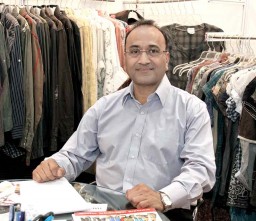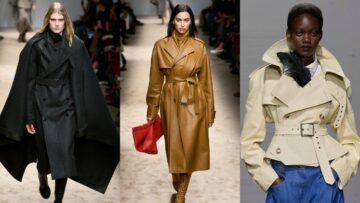Celebrating its golden jubilee the India International Garment Fair (IIGF) was a slow and, low key affair. Many of the small and medium level exporters exhibiting were looking towards new markets though the traditional markets of the US and EU still remains a priority. Many of the exporters who had pulled out from the US in the slowdown phase were keen to re-enter the market. On the product from the fair was an assortment of trends to meet a wide buyer preference, with little focus on forecasts. Team Apparel Online reviews what India has to offer buyers today…
xporting men’s shirts to UAE and Philippines, Cairo International, Delhi has recently done sampling for Mango and Zara for the European market. “Every brand of Europe is not badly hit, and some buyers/brands are doing good business even in this lean time. We are in touch with some of these buyers,” informed Lalit Agarwal, MD. The company had added 70 specialized machines 3 months back at its factory to produce 4,200 pieces per day and out of which 20 per cent is for the domestic market. The company is reluctant to work with new markets as the risk factor is very high.
Indeed moving into a new market is a big challenge and exporters are fully aware of the pitfalls. “My experience in Eastern Europe, Russia and Latin America shows that the working systems in these emerging markets is not systematic and we are habitual of US and Europe where buyers are quite professional. Even at IIGF, I have met many buyers who are unfamiliar with Indian production capabilities,” says Kirti Shah, Director, KM INC. The company is into men’s, ladies and kids upper segment specially exporting to Spain and Italy.
As positive indications are coming from US, many companies are eyeing the market for the future. Colors India, Jaipur, which has worked exclusively with Europe from the start has seen its FOBs decline sharply and is now looking at the US to support its capacities. “Spain and Portugal are still okay and our regular buyers are giving us the same quantity orders as most of them have their own stores, however, while earlier they were buying for 8 dollars now they are buying for 6 dollars. We are managing, but to maintain the bottomlines we are looking towards US as our styles are universal so we do not have to create separate collections for the market,” reasons Rajeev, Sr. Merchandiser & Designer. In the meanwhile, Vasu Clothing, Indore has again moved towards US after a four years gap.

Doing for Europe and US since a long time, U&I Exports, Delhi has diversified towards newer markets like South America, South Africa and Middle East only a couple of years ago. “They are not big markets but more consistent and business is picking up there. We are trying to get the lowest spectrum of the market to get better market share in terms of volume. In the time of recession people did not have money to spend on high-value products, so there has been a shift to lower price product which is catering to younger audience because that line is not very dependent on a particular season which continues to sell, and we are primarily looking at that market,” informs Uneet Chhabra, Director U&I Exports.
Young International, Noida earlier catering only to Europe, has expanded its business to South America and Turkey in the last three years. The main benefit working for South America is that they have reverse season compared to Europe so we get enough time to manage both markets,” says Vikash Gulati, Director, Young International. The company has increased 30 per cent capacity in last season and is now making 50,000 pieces per month of ladies and kidswear. FA Exports, Noida doing high-value beading apparels for Canada, UK and France is planning for South America, Australia and Nicaragua as it found some interesting customers there.
Buyers Reactions…

IIGF, known for small and middle level buyers, retained its image as a boutique fair. Running a small retail shop in Canada, Wiebke sources 2000 to 5000 pieces of ladies clothing and bed sheets from Delhi and Jaipur, Pushkar. “The market in Canada is okay and our customers still love high-value garments,” she says. Confirming positive signs from US, Anand Poddar, President, Sacred Threads, USA says, “Market is improving, but price is still a big challenge as even we have not increased our price in last 15 years. India has been supplying apparels to world at very cheap prices, so it is a trend with buyers to look for products under US $ 5.” For the last 21 years this firm is associated with 2500 stores
and is sourcing apparels worth US $ 1 million.
A big group from the UAE having its wholesale division and 7 retail stores by the name of Avenue, is sourcing more than 5,00,000 pieces per year from India. Harish Wadhwani (GM, Merchandising), Avenue LLC, UAE says, “Our focus in now on India as China market is facing price and labour issue majorly. India has ample opportunity in these conditions.”
Variety of products… sequin work, embroidery and prints dominate racks
A highly popular detail that was observed at the event and done by almost every exporter was the use of sequins. The high-value adding technique was seen on silhouettes like dresses, gowns, blouses, jackets and blazers. The type of sequins used varied in colours, sizes and somewhat in texture as well. Golden, silver, bronze, black and transparent sequins were seen to be most popular. Not just the size but the placement of sequins also varied from garment to garment. Overlapping, sheeting and scattered along with other elements like beads and threadwork were combined with sequin work. It was seen mostly on polyester fabrics; however nylon, organza and even knits weren’t that far behind. According to the exporters, there is a demand for sequins owing to the popularity of intricate embellishments from the Indian market.
Computerized embroideries with a wide variety of colourful threads were a major component of the exporters’ racks. The embroidery was done with the use of light to heavy threads. Colour was mostly the focus for computerized embroideries. And it was achieved either through monotones by using the thread of the same colour as the fabric or with neon’s and other vibrant colours. The embroideries were mostly computerized, however for a very few exceptions handwork was involved and it was predominantly done on fabrics like silk-organzas, polyester blends, in addition to cottons and knits. The embroideries patterns were designed to be floral, leafy and also tribal which was created by a sort of geometric effect in a set of bright colours.
Prints were a very popular trend used by a high percentage of exporters at the fair. One of the major prints that were spotted was tribal and floral print. These were seen in a variety of geometric as well as circular patterns. Intricate baroque and animal prints were seen not only on woven but knitwear as well. Dull paisleys in colours like maroon, beige, browns and navy blues were a common affair as well. There were hints of abstract animal prints in combination with florals and baroque inspired prints.
Many exporters mentioned that screen-printing was more popular than digital printing as it is not as highly priced. Depending on the type of prints the buyer is looking for, the exporter works on collections for individual orders. Kaftans, blouses, maxi dresses and sleepwear were the silhouettes seen with a big focus on prints. In terms of demand rotary prints were what the buyers were specifically looking for.
The buyers were mostly looking for subdued and earthy colours and intricate handwork, beading and cutwork, the kind of techniques and effects that give the garment an authentic Indian feel and influence. In scarves, the market is moving towards more digital prints with preferences in jungle prints, animal motifs, vintage and floral prints.











